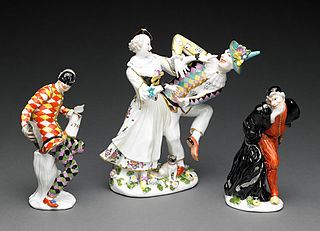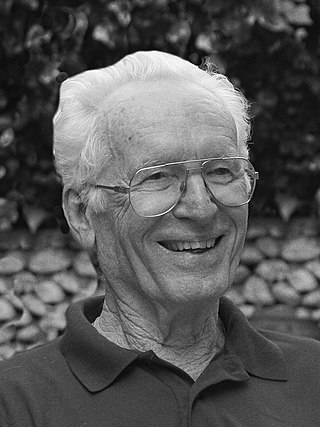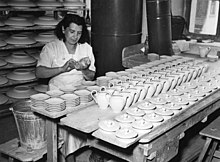
Luigi Colani was a German industrial designer.

Timo Tapani Sarpaneva was an influential Finnish designer, sculptor, and educator best known in the art world for innovative work in glass, which often merged attributes of display art objects with utilitarian designations. While glass remained his most commonly addressed medium, he worked with metal, wood, textiles, and porcelain (china). Sarpaneva has entered homes around the world through his industrial design of upscale, artistically conceived items, including cast-iron cookware and porcelain dinnerware. His work was among the key components that helped to launch Finland's reputation as a trailblazer of design.

Meissen porcelain or Meissen china was the first European hard-paste porcelain. Early experiments were done in 1708 by Ehrenfried Walther von Tschirnhaus. After his death that October, Johann Friedrich Böttger continued von Tschirnhaus's work and brought this type of porcelain to the market, financed by Augustus the Strong, King of Poland and Elector of Saxony. The production of porcelain in the royal factory at Meissen, near Dresden, started in 1710 and attracted artists and artisans to establish, arguably, the most famous porcelain manufacturer known throughout the world. Its signature logo, the crossed swords, was introduced in 1720 to protect its production; the mark of the swords is reportedly one of the oldest trademarks in existence.

Allach porcelain a.k.a. Porzellan Manufaktur Allach was produced in Germany between 1935 and 1945. After its first year of operation, the enterprise was run by the SS with forced labor provided by the Dachau concentration camp. The emphasis was on decorative ceramics —objets d'art for the Nazi regime. The company logo included stylized SS runes. Sometimes in place of the company name, the pottery markings mentioned the SS: "DES - WIRTSCHAFTS - VERWALTUNGSHAUPTAMTES". Ceramic artist, master potter and author Edmund de Waal describes the double-lightning insignia of the SS that marked the Allach products as a clever transposition of Germany's famed Meissen porcelain mark of two crossed swords.
The Design Award of the Federal Republic of Germany is the official design award for Germany presented by the German Ministry for Economics and Technology. The award was given for the first time under the name 'Federal Award for Good Design' in 1969 and thereafter every two years. Moreover, the focus of the award was changed on each occasion. The name of the award was first changed in 1992. Thereafter, the Federal Product Design Award and the Federal Award Promoter of Design — which went to a personality for achievements in the design field — were presented annually. Since 2006, it has been called the Design Award of the Federal Republic of Germany and is given for outstanding achievements in the fields of product and communication design, and to a personality in the design sector. Since 2012, the prize competition has been administered by DMY Berlin GmbH & Co. KG.

Arzberg is the trademark of a German manufacturer of porcelain, founded in 1887 in Arzberg, Bavaria. Its fame is largely based on designs by Hermann Gretsch, whose Form 1382, conceived in 1931 and based on Bauhaus principles, marks a milestone in modern design; Form 1382 is still produced today, and sold worldwide. Hutschenreuther AG, holder of the Arzberg trademark since 1972, was dissolved in 2000 and the trademark was taken over by SKV-Porzellan-Union GmbH, founded in 1993 by the porcelain companies Schirnding, Kronester and Johann Seltmann Vohenstrauß. In 2004, SKV-Porzellan-Union GmbH was renamed Arzberg-Porzellan GmbH. In 2003, the company had approximately 250 employees. Since 2000, however, the headquarters of the company holding the trademark Arzberg are located in Schirnding, where production took place. After 10 years Arzberg GmbH announced its insolvency. Today the trademark is owned by Rosenthal porcelain.

Karl Diebitsch was an artist and the Schutzstaffel (SS) officer responsible for designing much of the SS regalia during the Nazi era, including the chained SS officer's dagger scabbard. Diebitsch worked with graphic designer Walter Heck to draft the well-known all-black SS uniform. Also with his business partner, industrialist Franz Nagy, Diebitsch began the production of art porcelain at the factory Porzellan Manufaktur Allach.
The CeramTec Group is a developer and manufacturer of products and components made of technical ceramics. The products are marketed through its own sales companies, among others. They are primarily used in medical technology, automotive engineering, electronics, equipment and mechanical engineering, environmental and energy technology, toolmaking, the chemical industry and the semiconductor industry. The company is headquartered in Plochingen in Baden-Württemberg, Germany.

Gero Trauth is a German painter, graphic artist, porcelain illustrator and designer.

The Royal Porcelain Factory in Berlin, also known as the Royal Porcelain Manufactory Berlin and whose products are generally called Berlin porcelain, was founded in 1763 by King Frederick II of Prussia. Its actual origins, however, lie in three private enterprises which, under crown patronage, were trying to establish the production of "white gold" in Berlin from the mid-18th century onwards.

Herbol is one of the oldest German brands for professional coatings. It has its origins in the Lackfabrik Herbig-Haarhaus that was founded in Cologne in 1844. The product range contains façade paints, interior wall paints, lacquers and glazing, crack reinforcement as well as concrete and floor system. The coatings systems are used for renovation, maintenance and new constructions. Since 1999 the brand Herbol is part of the Akzo Nobel Deco GmbH, an affiliate of the Dutch concern AkzoNobel, the world's biggest coatings manufacturer.
Weimar Porzellanmanufaktur, or Weimar Porzellan is a German company that has been manufacturing porcelain in Weimar since 1790.
The Könitz Porzellan GmbH is a company in Könitz, a district of the commune Unterwellenborn. The company includes the Wiedemannsche Druckerei, the brand WAECHTERSBACH as well as the Weimarer Porzellanmanufaktur.
Philipp Rosenthal was a German designer and industrialist of Jewish descent. Rosenthal founded the company Philipp Rosenthal & Co. AG in 1897 for the production of ceramic wares.

Philip Rosenthal was a German industrialist, socialite and Social Democratic Party politician. In 1950, Rosenthal regained control of the family's company Rosenthal AG after the fall of Nazi Germany. In 1968, Rosenthal was awarded the Bavarian Order of Merit and in 1981, the Order of Merit of the Federal Republic of Germany. From 1970 to 1971, he served as Germany's Parliamentary Secretary of State under the Ministry of Economic Affairs. Rosenthal was a public figure, and in addition to being Germany's "China King", he was often recognized for his eccentric lifestyle and personality.
Albert Caasmann was a German sculptor and porcelain artist. Caasmann designed toy figures for the Berlin toy company Lineol and from 1919 to 1952 was the lead designer and production manager for the company. He designed figurines for the porcelain companies Rosenthal AG and Volkstedt. Caasmann's work for the company Rosenthal are exhibited in the Porzellanikon's Rosenthal Museum. Lineol toy figures modeled by Caasmann are in the Historical Toy Museum in Freinsheim and the Toy museum in Havelland.

The Porzellanikon is a museum complex dealing with the production of porcelain and ceramics in Selb and Hohenberg an der Eger in the district of Wunsiedel i. Fichtelgebirge (Oberfranken) in Germany. The complex of museums was the result of the merger of the European Industrial Museum for Porcelain, the European Museum of Technical Ceramics, the Rosenthal Museum and the German Porcelain Museum in Hohenberg an der Eger. Since 2012, the Porzellanikon has been included in the European Route of Ceramics as a member of the "UNIC".

Ludwigsburg porcelain is porcelain made at the Ludwigsburg Porcelain Manufactory founded by Charles Eugene, Duke of Württemberg, on 5 April 1758 by decree as the Herzoglich-ächte Porcelaine-Fabrique. It operated from the grounds of the Baroque Ludwigsburg Palace. After a first two decades that were artistically, but not financially, successful, the factory went into a slow decline and was closed in 1824. Much later a series of other companies used the Ludwigsburg name, but the last production was in 2010.

Alexander Cvijanović was a Yugoslav-American architect. He was a close associate of Walter Gropius and partner of The Architects Collaborative.
A variant of the category of French drip coffee pots is the group of "Bohemian" coffee pots, manual zero-bypass coffee makers made out of porcelain only, including Karlsbad coffee makers, Bayreuth coffee makers, the Walküre cup filter (2010) and the Walküre aroma-pot (2015). In contrast to French drip coffee pots they all use a special double-layered cross-slitted strainer made from through-glazed porcelain as well as a water spreader with six large round holes. Before World War I, they were very popular in the Viennese coffee house culture. The special kind of drip coffee they produce is called a Karlsbader.























